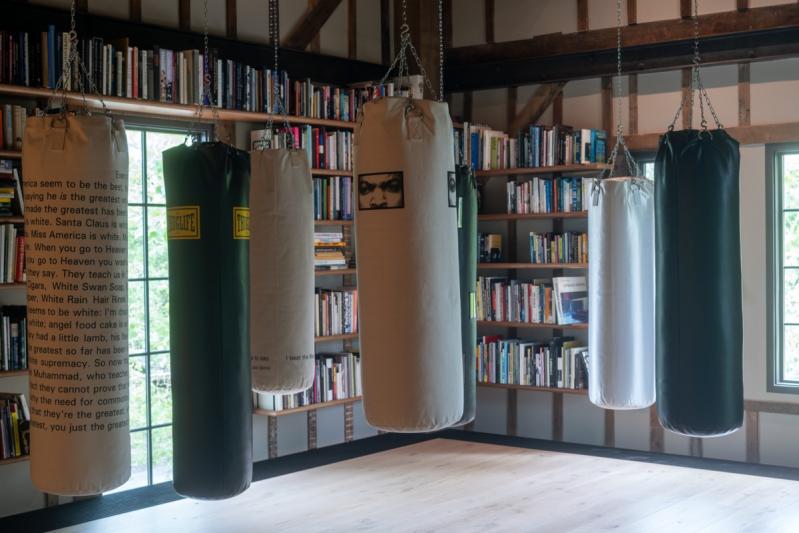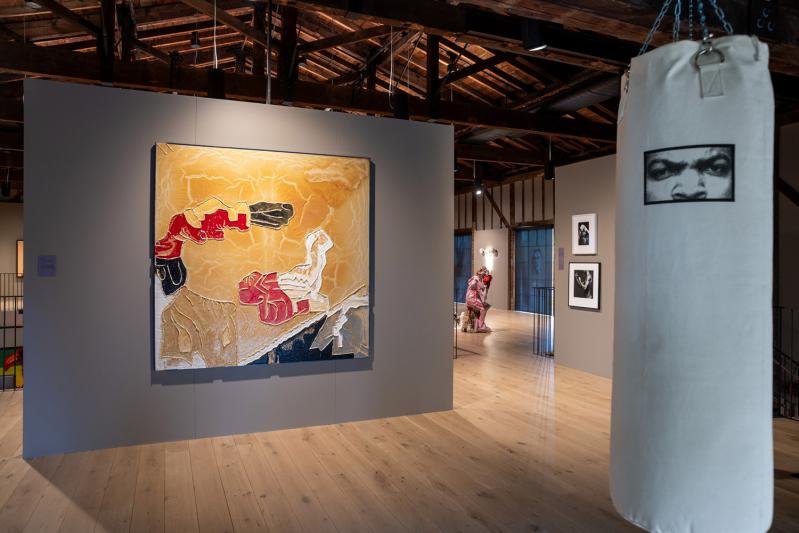In its short existence, The Church in Sag Harbor has become a reliable platform for exhibitions that are a nexus for local and international artists as they uniquely interpret a common theme.
This summer the subject is boxing, an unexpected but actually prolific subject for many artists across gender, race, career level, and other demographics. As a metaphor, it turns out to offer multiple connotations and denotations that contribute to an almost universality of significance.
The rich vein of material was such that the exhibition "Strike Fast, Dance Lightly: Artists on Boxing" carried over to another location, the Flag Foundation in Chelsea. The shows have (or had, the Flag Foundation version closed on Aug. 11) examples of what might be considered the more well-known practitioners of the genre: the early-20th-century realist depictions of pugilists in the ring by George Bellows (whose mother was from Sag Harbor and whose work was in the Flag Foundation show), Eadweard Muybridge's motion studies, LeRoy Neiman's depictions of sporting life, and Glenn Ligon's punching bags inspired by Muhammad Ali, hip-hop, notions of masculinity, and commodification of Black anger that were made in collaboration with the Fabric Workshop (not to be confused with Jeffrey Gibson's "War Is Not the Answer Feel Something Real," a punching bag embellished with glass beads and felt letters also on view). These familiar paragons provide grounding or context for the rest of the artworks that examine the subject in a range from the literal to way-off-the-map detours, both rigorous and exhilarating.
The Church's show was curated by Sara Cochran, its chief curator, and Eric Fischl, a co-founder of the arts center with April Gornik, a fellow artist and his wife. In a statement, they say boxing is "shorthand for the existential question 'what is worth fighting for?' and themes of struggle, defiance, victory, martyrdom, and brutality."

Our present moment crackles with a buzzy current of protest and violence. The contemporary works seem to capture this force and go on to question the traditional practice of the sport and what it tells us about our history and situation now. Who knew gloves or fighters or boxing rings could be such malleable tropes? Clearly the organizers did, or they soon discovered it.
You have to love an exhibition in which you are both greeted and immediately displaced by Vito Acconci's voice muttering how he wants to be alone. Then, on a video monitor evident at first only through the stair risers on the ground floor, his blurred countenance is visible as he grips a pipe or crowbar.
The building's architecture works brilliantly with this piece, a recording of a performance from 1971, when it is re-encountered on the second floor and discerned through the metal-grated borders of where floor meets wall. The acoustics send his voice aloft like incense or snippets from an ancient sermon. The implied potential for violence sets up a confrontational form of menace that underlines certain themes that repeat in the improvised galleries created by floating walls in the open spaces.
Yet few works actually rise to that initial implied threat. Many seem to defuse rather than ignite. Bill King's attenuated featherweight wooden "Boxer" and Barry Flanagan's similarly slight "Large Boxing Hare on Anvil" (placed outside) seem as though a strong breeze or guffaw could blow them over -- not to mention Jeanne Silverthorne's literal "Skeleton With Boxing Gloves and Crate."
The "I'm an artist, not a fighter" vibe of Michael Halsband's portraits of Andy Warhol and Jean-Michel Basquiat "boxing" is the height of irony, a sendup of a brutal masculinity not the least bit evident in these images.
Contrasted with the intensity of Sonny Liston's stare in Paul Davis's portrait, Ed Paschke's "Boxer With Masque," Jules Feiffer's literally graphic depictions of fighting in the ring, Howard Kanowitz's "Untitled (Boxing)" charcoal drawing, or Paul Pfeiffer's "Caryatid (Pacquiao)," in which a boxer is fighting an opponent made invisible on video, turning the ring into a violent shadowboxing dance floor, most works tend not to be directly aggressive, even when they are depicting fighters. In Fab 5 Freddy's depiction of Jack Johnson, embellished (or bedazzled) with Swarovski crystals, his dukes may be up, but he seems frozen in space and time, more pose than follow-through.
When women tackle the subject, it can be sincere, ironic, symbolic, or any number of other gambits. Delilah Montoya is represented by powerful portraits of female boxers posing outside the ring. Alison Saar has a sculptural installation piece, "Black Lightning," from 2012, that includes glass boxing gloves that fill with red liquid siphoned from a bucket on the floor. A mop and stool complete the assemblage, which is heavy with meaning and filled with implied spilled blood and injury.
Boxing gloves appear to be stand-ins for ovaries in two pieces, one by a female artist, Zoe Buckman, who uses white gloves as the ovaries in a woman's reproductive system otherwise expressed in white neon tubing. Although it seems defensive and fortified, particularly post-Roe, she has said the piece's message was intended to transcend gender. It's why she kept a larger public art version white after initially thinking about making it pink.
"Part of marrying the uterus to the boxing gloves wasn't just about being in 'fight mode' as women in this society, but about creating a sculpture that felt like an intersection between masculinity and femininity," she told a publication put out by the Standard hotels chain.
Charles Waller's 2004 "Plie (from the Bridal Suite)" is an assemblage with a Victorian wedding dress as its focal point, with other objects attached. Two antique boxing gloves placed on both sides of the dress at around hip level seem to evoke ovaries. Rather than white and fertilely puffy like Ms. Buckman's, the gloves are faded, worn, even dried up. It's typical of Waller (who died in 2021) to have sarcasm bound up in something also redolent of death.
On the other end of the gender pool, Gary Simmons's 1993 "Everforward . . ." hangs a pair of pristine white boxing gloves from satin ribbon. The way the gloves land against the wall can be abstractly suggestive of male anatomy, moving the gloves' signifier needle back into the masculine realm.
As in all group shows, there are plenty of other pieces that bear more attention than this space allows. There is still time left to see them, but "Strike Fast," since the last day of the show is approaching on Sept. 3, and like the summer, it too will soon be gone. The show will, however, travel to Palm Beach's Norton Museum of Art in December.




